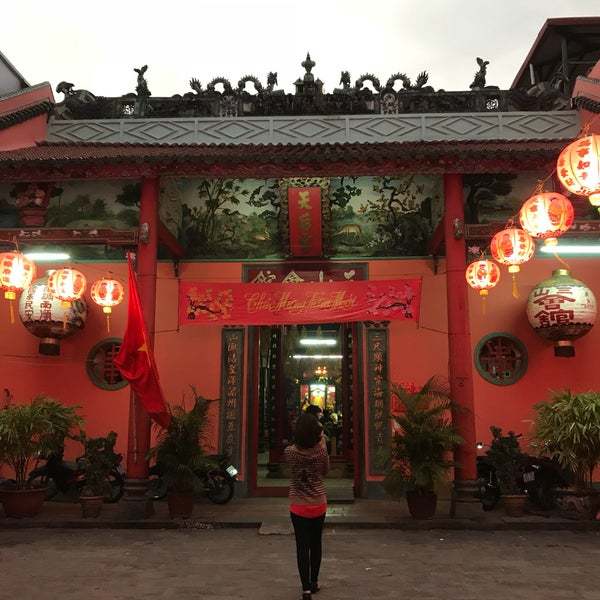The Assembly Halls of the Chinese community in Vietnam have a rich and intricate history, often characterized as shrines, pagodas, temples, or other similar structures. These halls serve as sacred places for worship and community-centric events, aligning with the beliefs and practices of different origins and professions within the community.
Ho Chi Minh City is home to approximately 30 Assembly Halls of the Chinese community, with many dating back over two centuries. These Assembly Halls are located throughout the city, but are primarily concentrated in District 5, specifically around Nguyen Trai, Trieu Quang Phuc, Chau Van Liem, Tran Hung Dao, and Hai Thuong Lan Ong. Some notable Assembly Halls include Ha Chuong, Tue Thanh, Nghia An, Quynh Phu, and Phuoc An, among others. In addition to serving as gathering places, most of these Assembly Halls are also associated with shrines and temples.
Traditional buildings from different linguistic groups, including Minh Huong, Chaozhou, Cantonese, and Fujian, are adorned with distinctive red colors to set them apart from other architectural styles in the area.
According to traditional Chinese feng shui, the color red is associated with positive outcomes such as good fortune, happiness, and wealth. The roofs of assembly halls are constructed using rows of overlapping tiles in shades of blue or yellow, forming multiple layers.
For Vietnamese speakers, the “Chinese Pagoda,” also known as a Chinese temple, holds great significance as a place of worship for the Chinese community’s revered deities, including Thien Hau Thanh Mau, Quan Cong, Phuc Duc Chinh than, and various other gods, including Buddha.
According to analysts, the assembly hall of the Chinese community in Ho Chi Minh City has a unique attribute, apart from its “shared abode” theme. It serves as the headquarters of the organization, fulfilling various additional responsibilities.
According to Assoc. Prof. Dr. Phan An of the Institute of Social Sciences in the Southern region, there is a connection between the assembly hall and temples of the Chinese community that addresses both their physical and mental needs.
The assembly halls of the Chinese community in Saigon originally served as meeting venues for community members. The elected leader of a state should inspire trust and possess expertise. Additionally, it is important for this leader to have both wealth and business acumen for the efficient functioning of the society.
The mayor of the Chinese community serves as a vital connection between the local administration and the community. This role entails ensuring order and security within the community, and effectively communicating the government’s directives and perspectives. Additionally, the mayor is tasked with collecting state taxes from citizens on behalf of the government.
The individual also assumes the role of conflict resolution within the state and the cantons, promoting a robust sense of solidarity, assistance, and community support among its members.
 |
|
The aforementioned is a venue known as the assembly hall of the Chinese community in District 5, HCM City. |
The assembly halls of the Chinese community have a significant economic function. They serve as a meeting place for merchants from the same state, facilitating business discussions and assisting in locating suppliers and marketplaces. Additionally, these halls serve as a platform for Chinese merchants of the same dialect to engage in transactions and promote commerce in Saigon’s Assembly Halls.
Assembly Halls of the Chinese community in Ho Chi Minh City serve as important social and meeting spaces, where individuals come together to engage in intellectual discussions, deliberate on various matters, collaborate on projects, and more. Moreover, these halls also ensure that the most vulnerable members of society receive essential aid and encouragement. All clubs within the community can partake in charitable initiatives facilitated by these assembly halls. In essence, the assembly halls played a pivotal role in the enduring existence of the Chinese community in historic Saigon.
Regarding cultural duty, the assembly halls of the Chinese community in Saigon – Ho Chi Minh City are consistently associated with religious institutions. These establishments are commonly known as either a Chinese pagoda, using the official name or as an assembly hall combining both.
The assembly hall of the Chinese community in Vietnam holds a significant place in Vietnamese history for various reasons. Serving as a crucial resource to safeguard the cultural heritage of the Chinese people, these assembly halls form a vital hub for community interaction, facilitating gatherings, cultural exchanges, commerce, and serving as an integral component of Chinese life in Vietnam.
The Chinese assembly hall in Vietnam holds great significance, as it is deeply rooted in the history of immigration, settlement, and cultural assimilation. One of the key factors contributing to the preservation of Chinese heritage and way of life is the utilization of assembly halls. These halls serve as a hub for community interaction, stimulating the exchange of ideas among members and facilitating business activities. Additionally, assembly halls play a vital role in the integration of the Chinese community into the local social fabric, all while carefully safeguarding their distinct cultural characteristics.
<Hang Linh>



